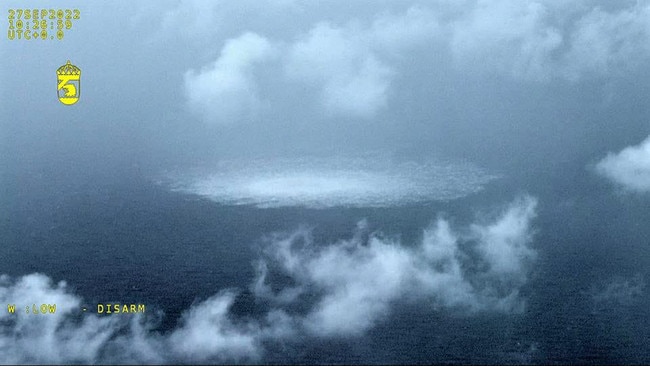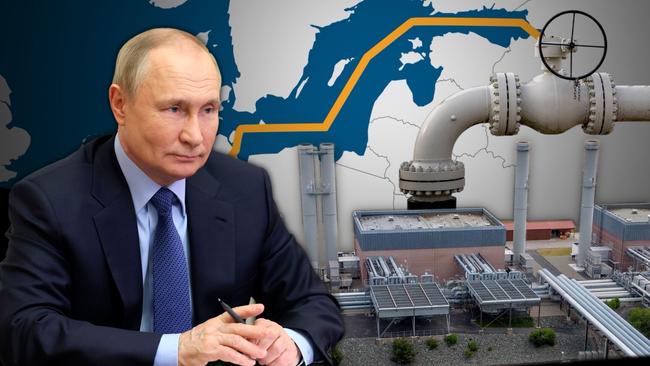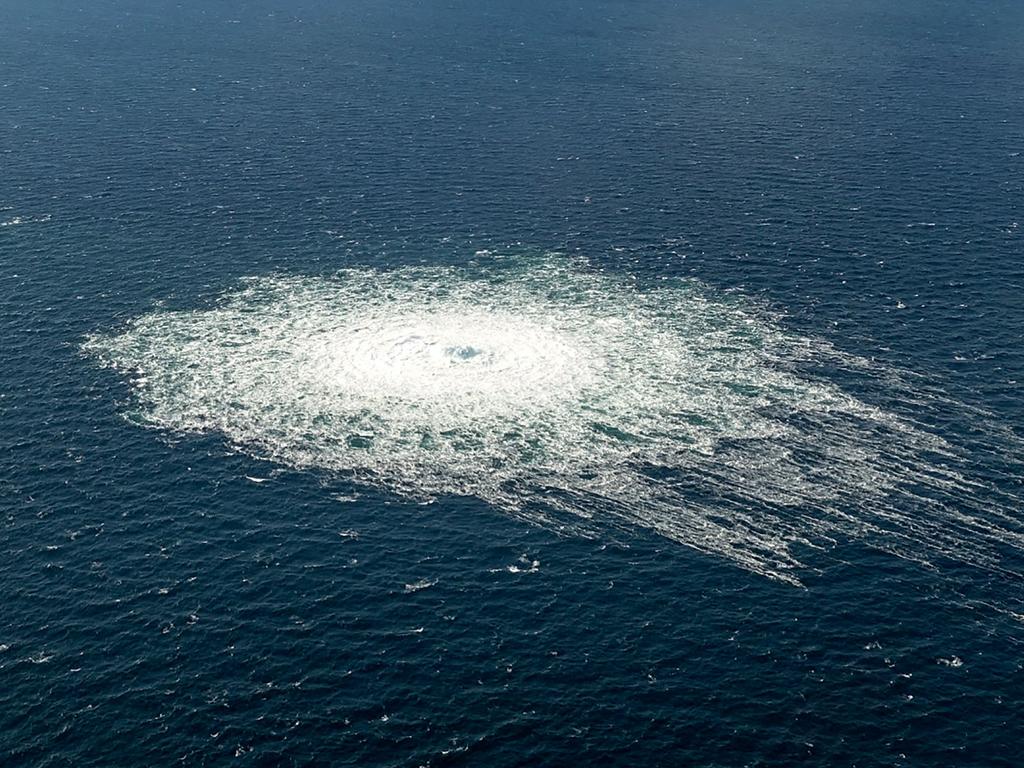Nord Stream leaks spur scramble to protect Europe’s energy infrastructure
European governments race to safeguard their energy infrastructure after leaks on two Russian gas pipelines that officials say were sabotage.

European governments raced to safeguard their energy infrastructure after detecting leaks on two major Russian natural-gas pipelines that officials said were the result of sabotage.
The European Union on Wednesday threatened retaliation for any further attack on Europe’s energy facilities following the incidents on the Nord Stream and Nord Stream 2 pipelines. The pipes suffered a significant pressure drop on Monday and began leaking gas into the sea.
While the incidents don’t affect Europe’s gas supply because the pipelines aren’t currently in use, they have raised fears about the safety of the continent’s energy systems as governments are racing to shore up their gas supplies for the winter.
Grids, pipelines, telecommunication cables and other vital infrastructure are normally built to withstand accidents but not deliberate attacks. Securing them would add to the financial and logistical burden Europe faces as it seeks to shield itself from its aggressive neighbor.
The Nord Stream incidents, which disrupted shipping and raised environmental concerns, add to a combustible situation in European geopolitics and energy markets.
The U.S. and several European governments have pledged to get to the bottom of it. Some officials and analysts have pointed the finger at Russia. The Kremlin on Wednesday called the allegations that it was responsible “predictable and predictably stupid.” It has said it was concerned about the incidents and called for a thorough investigation.
Later Wednesday, Russia’s Foreign Ministry said it would call a U.N. Security Council meeting in connection with what it called “provocations” regarding the two pipelines.
The EU is already drawing up new sanctions to impose on Russia after President Vladimir Putin escalated his war on Ukraine last week by mobilizing hundreds of thousands of troops and threatening nuclear strikes.
The EU’s foreign-policy chief, Josep Borrell, said the leaks suggested a deliberate act and the bloc would take “further steps to increase our resilience in energy security.” Norwegian police on Wednesday reinforced security around the country’s oil-and-gas installations a day after Denmark said it would strengthen safety measures around energy infrastructure. Germany’s economy minister, Robert Habeck, warned that critical infrastructure in Europe is now a target.

“These incidents are not a coincidence and affect us all,” Mr. Borrell said. “Any deliberate disruption of European energy infrastructure is utterly unacceptable and will be met with a robust and united response.” North Atlantic Treaty Organization Secretary-General Jens Stoltenberg on Wednesday said he discussed the protection of critical infrastructure in NATO countries with Danish Defense Minister Morten Bødskov. National security adviser Jake Sullivan said in a tweet that the “U.S. is supporting efforts to investigate and we will continue our work to safeguard Europe’s energy security.” The German navy will be deployed to help with the investigation, Defense Minister Christine Lambrecht said on Wednesday. “The presumed sabotage of the Baltic Sea pipelines shows us once again that we are dependent on critical infrastructure, including underwater.” Tobias Federico, managing director of consulting firm Energy Brainpool, said the incident raises fears that all critical infrastructure in Europe, from North Sea oil-and-gas pipelines and power cables linking continental Europe, Scandinavia and the U.K. to internet cables, could come under threat.
“It’s a pretty powerful proof of capability,” he said.
Gassco AS, which operates most of the gas pipelines in Norway -- now Europe’s single biggest source -- said it had raised its security precautions following the Nord Stream leaks.
The Russian pipes have two different owners. Nord Stream is owned by a Switzerland-based company, Nord Stream AG, whose shareholders include Russia’s state gas exporter Gazprom PJSC as well as European energy companies such as Germany’s Wintershall Dea AG and France’s Engie SA. The project, pushed by Mr. Putin and then German Chancellor Angela Merkel, was launched in 2011 despite protests by Eastern European and Ukrainian leaders who said it would give Russia additional leverage over European energy markets. Over the next decade, it overtook Ukraine as the biggest route for Russian gas into Europe.
Ignoring objections from the U.S., Ms. Merkel pursued a second subsea pipeline, Nord Stream 2, owned by a Swiss subsidiary of Gazprom. Engineers finished laying the pipe in 2021 and it was expected to double the volume of gas that Russia could send directly to Germany. Ms. Merkel’s successor, Olaf Scholz, indefinitely suspended authorization for the pipeline days before Russia’s invasion of Ukraine in February. The U.S. has hit the company with sanctions.
The leaks, along with a separate flare-up in tensions between the Russian and Ukrainian state energy companies, raised nerves among traders about the prospect for further supply disruptions. Russia had already throttled gas exports to Europe in recent months in what European officials have called an economic attack.
European benchmark gas prices rose around 7% Wednesday after falling in recent weeks.
Late Tuesday, Gazprom said Russia might impose sanctions on Ukrainian state gas company NJSC Naftogaz that would prevent it from transacting with the Kyiv-based firm. It said the sanctions might be imposed if Naftogaz continued with international arbitration proceedings against Gazprom for what Naftogaz alleged were payment failures.
Traders and analysts said the statement appeared to be a threat to cut off supplies to Europe through Ukrainian pipelines because Gazprom pays Naftogaz to shuttle fuel to the continent. Since Nord Stream and a separate Polish pipeline went down earlier this year, Ukraine has been the biggest remaining route by which Russian gas reaches the continent. Slovakia, the Czech Republic, Austria and Italy are particularly vulnerable to a cutoff.
“It’s weird they threatened us on behalf of the Russian state,” Naftogaz Chief Executive Yuriy Vitrenko said in an interview, adding that the company hadn’t received any indication from the Russian government that it would be sanctioned, and that he would pursue the arbitration claim. “It would just be easier for them to say we don’t want to deliver into Europe,” he said.
The incident comes as European security forces monitor increased military activity by Russia in the area.
“There is reason to be concerned about the security situation in the Baltic Sea region,” Mr. Bødskov said Wednesday. “Despite the war efforts in Ukraine, Russia has a significant military presence in the Baltic Sea region and we expect them to continue their saber-rattling.” Seismologists registered two powerful tremors in the areas of the gas leaks near the Danish island of Bornholm on Monday that they said weren’t earthquakes and pointed to blasts.
The Nord Stream pipelines are laid mostly along the seabed, and each is more than 750 miles long. More than 2.4 million tons of steel was used to build the Nord Stream pipeline -- around 242 times the weight of the Eiffel Tower -- according to its operator.
The pipelines are coated with concrete to guarantee their stability, according to the operator. Without the concrete, they might float off the seabed because of the volume of gas they contain, a European industry official who worked on the pipelines said.
“This is not a leak -- it’s a fountain,” the person said of the incident. He said both pipelines met the highest international standards designed to prevent them from springing leaks if they were struck by trawling nets or anchors, or if seismic activity occurred nearby.
“These pipes are built to be protected against all kinds of accidents,” said James Henderson, chairman of the Gas Research Program at the Oxford Institute for Energy Studies. “It looks like a fairly sophisticated act of sabotage, especially at these depths.” He said that gas pipelines usually have intermittent emergency valves so that operators can isolate and turn off sections of pipe, thereby not allowing all the gas that is in the pipelines to leak out. Given the strength of the pipelines, it is unlikely that they would collapse and they would fill with water as the gas escapes.
Analysts said authorities would first use diving robots to survey the situation. To fix the pipeline, authorities would need a specialized ship to replace the whole damaged section.
The operator of the Nord Stream pipeline said it was mobilizing resources for a survey campaign to assess the damages in cooperation with local authorities. It said it wasn’t currently possible to estimate a time frame for restoring the gas transport infrastructure.
The Wall Street Journal






To join the conversation, please log in. Don't have an account? Register
Join the conversation, you are commenting as Logout